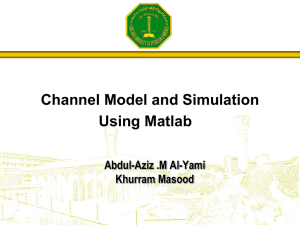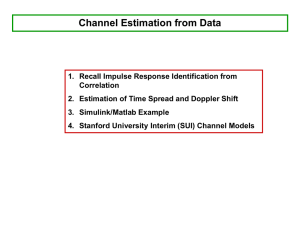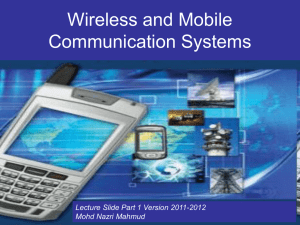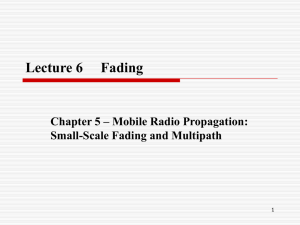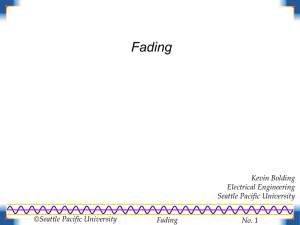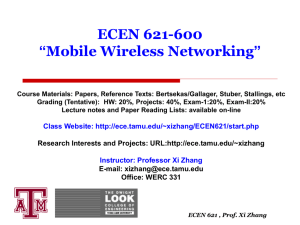Small scale fading
advertisement
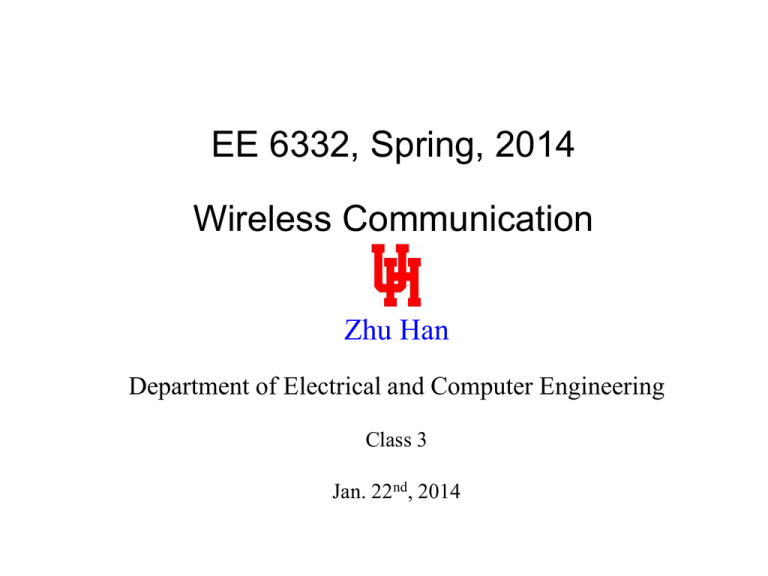
EE 6332, Spring, 2014 Wireless Communication Zhu Han Department of Electrical and Computer Engineering Class 3 Jan. 22nd, 2014 Outline Review – Large scale models: Chapter 2 Log-distance path loss model log-normal shadowing Small Scale Fading: Chapter 3 – Small-scale Multipath Propagation – Impulse Response Model of a Multipath Channel – Small-scale Multipath Measurements Multiply Three Effects ECE6331 Spring 2009 Free Space Path Loss Path Loss is a measure of attenuation based only on the distance to the transmitter Free space model only valid in far-field; – Path loss models typically define a “close-in” point d0 and reference other points from there: d Pr (d ) Pr (d0 ) 0 d 2 PL (d ) [ Pr (d )] dB d PL (d 0 ) 2 d 0 dB Log-distance generalizes path loss to account for other environmental factors d PL (d ) PL (d 0 ) – Choose a d0 in the far field. d 0 dB – Measure PL(d ) or calculate Free Space Path Loss. 0 – Take measurements and derive empirically. Typical large-scale path loss Log-Normal Shadowing Model Shadowing occurs when objects block LOS between transmitter and receiver A simple statistical model can account for unpredictable “shadowing” – PL(d)(dB)=PL(d)+X0, – Add a 0-mean Gaussian RV to Log-Distance PL – Variance is usually from 3 to 12. – Reason for Gaussian Measured large-scale path loss Determine n and by mean and variance Small-Scale Fading Rapid fluctuations of radio signal amplitude, phase, or delays Occurs or short time period or short travel distance Large-scale path loss effects can be ignored Caused by arrival of two or more waves from the source combining at the receiver Resultant detected signal varies widely in amplitudes and phase Bandwidth of transmitted signal is important factor Experimental record of received signal envelope in an urban area Multipathradio propagation in urban areas Determining the impulse response of a channel Transmit a narrowband pulse into the channel Measure replicas of the pulse that traverse different paths between transmitter and receiver Doppler Shift Comparison of the BER for a fading and non-fading channel Parameters of Mobile Multipath Channels Time Dispersion Parameters – Grossly quantifies the multipath channel – Determined from Power Delay Profile (average over different time, a function of delay) – Parameters include Mean Access Delay RMS Delay Spread Excess Delay Spread (X dB) Coherence Bandwidth Doppler Spread and Coherence Time Power Delay Profiles Power delay profiles are generally represented as plots of relative received power as a function of excess delay with respect to a fixed time delay reference. Power delay profiles are found by averaging instantaneous power delay profile measurements over a local area. Are measured by channel sounding techniques Plots of relative received power as a function of excess delay They are found by averaging intantenous power delay measurements over a local area Local area: no greater than 6m outdoor Local area: no greater than 2m indoor Samples taken at l/4 meters approximately For 450MHz – 6 GHz frequency range. Impulse Response Model of a Multipath Channel PDP Outdoor PDP Indoor Time Dispersion Parameters The mean excess delay, rms delay spread, and excess delay spread (X dB) are multipath channel parameters that can be determined form a power delay profile. The mean excess delay is the first moment of the power delay profile and is defined as ak2 k k ak 2 P ( k ) k k P ( k ) k k The rms delay spread is the square root of the second central moment of the power delay profile, where 2 ( ) 2 ak2 k2 2 k ak 2 k P ( k ) k2 k P ( k ) k Typical values of rms delay spread are on the order of microseconds in outdoor mobile radio channel and on the order of nanoseconds in indoor radio channel Maximum Excess Delay (X dB) Maximum Excess Delay (X dB): Defined as the time delay value after which the multipath energy falls to X dB below the maximum multipath energy (not necesarily belongingto the first arriving component). It is also called excess delay spread. The maximum excess delay is defined as (x - 0), where 0 is the first arriving signal and x is the maximum delay at which a multipath component is within X dB of the strongest arriving multipath signal. The value of x is sometimes called the excess delay spread of a power delay profile. In practice, values depend on the choice of noise threshold used to process P(). The noise threshold is used to differentiate between multipath components and thermal noise. Noise Thresholds – The values of time dispersion parameters also depend on the noise threshold (the level of power below which the signal is considered as noise). – If noise threshold is set too low, then the noise will be processed as multipath and thus causing the parameters to be higher. RMS Delay Spread Effect of delay spread Effect on error rate Coherent bandwidth Analogous to the delay spread parameters in the time domain, coherence bandwidth is used to characterize the channel in the frequency domain. Coherence bandwidth is a statistical measure of the range of frequencies over which the channel can be considered flat. Two sinusoids with frequency separation greater than Bc are affected quite differently by the channel. f1 Receiver f2 Multipath Channel Frequency Separation: |f1-f2| Coherence Bandwidth Frequency correlation between two sinusoids: 0 <= Cr1, r2 <= 1. Coherence bandwidth is the range of frequencies over which two frequency components have a strong potential for amplitude correlation. 1 – is rms delay spread BC 50 – If correlation is above 0.9, then 1 – If correlation is above 0.5, then BC 5 – This is called 50% coherence bandwidth Example For a multipath channel, is given as 1.37ms. The 50% coherence bandwidth is given as: 1/5 = 146kHz. – This means that, for a good transmission from a transmitter to a receiver, the range of transmission frequency (channel bandwidth) should not exceed 146kHz, so that all frequencies in this band experience the same channel characteristics. – Equalizers are needed in order to use transmission frequencies that are separated larger than this value. – This coherence bandwidth is enough for an AMPS channel (30kHz band needed for a channel), but is not enough for a GSM channel (200kHz needed per channel). Coherence Time Delay spread and Coherence bandwidth describe the time dispersive nature of the channel in a local area. They don’t offer information about the time varying nature of the channel caused by relative motion of transmitter and receiver. Doppler Spread and Coherence time are parameters which describe the time varying nature of the channel in a small-scale region. Doppler Spread Measure of spectral broadening caused by motion, the time rate of change of the mobile radio channel, and is defined as the range of frequencies over which the received Doppler spectrum is essentially non-zero. We know how to compute Doppler shift: fd Doppler spread, BD, is defined as the maximum Doppler shift: fm = v/l If the baseband signal bandwidth is much less than BD then effect of Doppler spread is negligible at the receiver. Coherence Time Coherence time is the time duration over which the channel impulse response is essentially invariant. If the symbol period of the baseband signal (reciprocal of the baseband signal bandwidth) is greater the coherence time, than the signal will distort, since channel will change during the transmission of the signal . TS Coherence time (TC) is defined as: TC TC f2 f1 t1 Dt=t2 - t1 t2 1 fm Coherence Time 0.423 Coherence time is also defined as: TC fm Coherence time definition implies that two signals arriving with a time separation greater than TC are affected differently by the channel. 9 16f m2 Coherence time Tc is the time domain dual of Doppler spread and is used to characterize the time varying nature of the frequency dispersive-ness of the channel in the time domain. If the coherence time is defined as the time over which the time correlation function is above 0.5, then the coherence time is approximately, T 9 where f m v c 16f m l Types of Small-scale Fading Small-scale Fading (Based on Multipath Tİme Delay Spread) Flat Fading Frequency Selective Fading 1. BW Signal < BW of Channel 1. 2. 2. Delay Spread < Symbol Period BW Signal > Bw of Channel Delay Spread > Symbol Period Small-scale Fading (Based on Doppler Spread) Fast Fading 1. 2. 3. High Doppler Spread Coherence Time < Symbol Period Channel variations faster than baseband signal variations Slow Fading 1. 2. 3. Low Doppler Spread Coherence Time > Symbol Period Channel variations smaller than baseband signal variations Flat Fading Occurs when symbol period of the transmitted signal is much larger than the Delay Spread of the channel – Bandwidth of the applied signal is narrow. – If Bs Bc , and Ts Flat fading May cause deep fades. – require 20 or 30 dB more power to achieve low BER during times of deep fades. – Increase the transmit power to combat this situation. The spectral characteristics of the transmitted signals are preserved at the receiver, however the strength of the received signal changes with time. Flat fading channels are known as amplitude varying channels or narrowband channels. Radio channel has a constant gain and linear phase response over a bandwidth which is greater than the bandwidth of the transmitted signal. It is the most common type of fading described in the technical literature. Flat Fading s(t) h(t,) r(t) TS 0 TS Occurs when: BS << BC and TS >> 0 0 TS+ BC: Coherence bandwidth BS: Signal bandwidth TS: Symbol period : Delay Spread Frequency Selective Fading Occurs when channel multipath delay spread is greater than the symbol period. – Symbols face time dispersion – Channel induces Intersymbol Interference (ISI) Bandwidth of the signal s(t) is wider than the channel impulse response. Radio channel has a constant gain and linear phase response over a bandwidth which is smaller than the bandwidth of the transmitted signal. Frequency selective fading is due to time dispersion of the transmitted symbols within the channel. Thus the channel induces inter-symbolinterference. Statistical impulse response model and computer generated impulse responses are used for analyzing frequency selective small-scale fading. Frequency selective fading channels are known as wideband channels since the BW of the signal is wider than the BW of the channel impulse response. As time varies, the channel varies in gain and amplitude across the spectrum of s(t), resulting in time varying distortion in the received signal r(t). If Bs Bc , and 0.1Ts Frequency selective fading Frequency Selective Fading s(t) r(t) h(t,) TS 0 TS 0 0 TS TS+ Causes distortion of the received baseband signal Causes Inter-Symbol Interference (ISI) Occurs when: BS > BC and TS < As a rule of thumb: TS < Fast Fading Due to Doppler Spread BS: Bandwidth of – Rate of change of the channel characteristics is larger than the the signal Rate of change of the transmitted signal Occurs when: BD: Doppler – The channel changes during a symbol period. Spread BS < BD – The channel changes because of receiver motion. TS: Symbol and Period – Coherence time of the channel is smaller than TS > TC TC: Coherence the symbol period of the transmitter signal Bandwidth – It causes frequency dispersion due to Doppler spread and leads to distortion. – Note that, when a channel is specified as a fast or slow fading channel, it does not specify whether the channel is flat or frequency selective A flat, fast fading channel the amplitude of the delta function varies faster than the rate of change of the transmitted baseband signal. A frequency selective, fast fading channel the amplitudes, phases, and time delays of any one of the multipath components varies faster than the rate of change of the transmitted baseband signal. Slow Fading Due to Doppler Spread – Rate of change of the channel characteristics is much smaller than the rate of change of the transmitted signal Occurs when: BS >> BD and TS << TC BS: Bandwidth of the signal BD: Doppler Spread TS: Symbol Period TC: Coherence Bandwidth Different Types of Fading With Respect To SYMBOL PERIOD TS Flat Fast Fading Flat Slow Fading Symbol Period of Transmitting Signal Frequency Selective Fast Fading Frequency Selective Slow Fading TC TS Transmitted Symbol Period Different Types of Fading With Respect To BASEBAND SIGNAL BANDWIDTH BS Frequency Selective Fast Fading Frequency Selective Slow Fading Transmitted Baseband BC Signal Bandwidth Flat Fast Fading Flat Slow Fading BD Transmitted Baseband Signal Bandwidth BS

